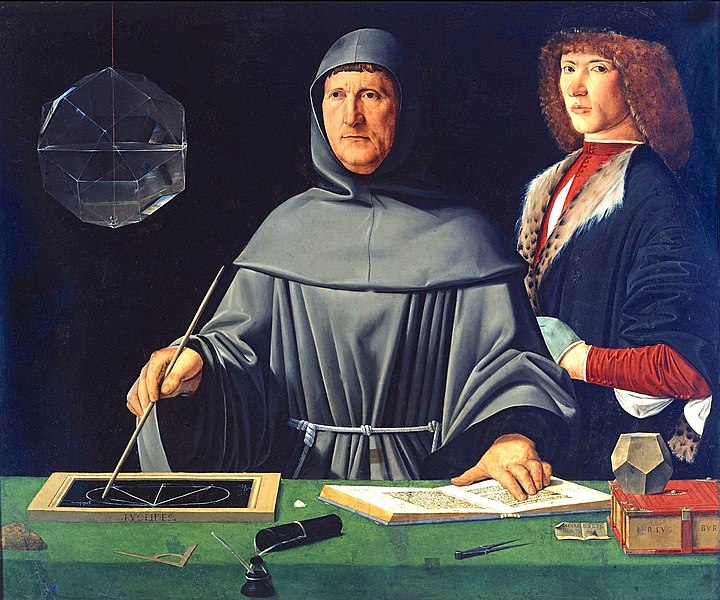Luca Pacioli and double-entry bookkeeping

When medieval Europe moved to a monetary economy in the 13th century, sedentary merchants depended on bookkeeping to oversee multiple simultaneous transactions financed by bank loans. One important breakthrough took place around that time: the introduction of double-entry bookkeeping, which is defined as any bookkeeping system in which there was a debit and credit entry for each transaction, or for which the majority of transactions were intended to be of this form. The historical origin of the use of the words 'debit' and 'credit' in accounting goes back to the days of single-entry bookkeeping in which the chief objective was to keep track of amounts owed by customers (debtors) and amounts owed to creditors. 'Debit,' is Latin for 'he owes' and 'credit' Latin for 'he trusts'.
Luca Pacioli's "Summa de Arithmetica, Geometria, Proportioni et Proportionalità" (early Italian: "Review of Arithmetic, Geometry, Ratio and Proportion") was first printed and published in Venice in 1494. It included a 27-page treatise on bookkeeping, "Particularis de Computis et Scripturis" (Latin: "Details of Calculation and Recording"). It was written primarily for, and sold mainly to, merchants who used the book as a reference text, as a source of pleasure from the mathematical puzzles it contained, and to aid the education of their sons. It represents the first known printed treatise on bookkeeping; and it is widely believed to be the forerunner of modern bookkeeping practice. In Summa Arithmetica, Pacioli introduced symbols for plus and minus for the first time in a printed book, symbols that became standard notation in Italian Renaissance mathematics. Summa Arithmetica was also the first known book printed in Italy to contain algebra.
Although Luca Pacioli did not invent double-entry bookkeeping, his 27-page treatise on bookkeeping contained the first known published work on that topic, and is said to have laid the foundation for double-entry bookkeeping as it is practiced today. Even though Pacioli's treatise exhibits almost no originality, it is generally considered as an important work, mainly because of its wide circulation, it was written in the vernacular Italian language, and it was a printed book.
According to Pacioli, accounting is an ad hoc ordering system devised by the merchant. Its regular use provides the merchant with continued information about his business, and allows him to evaluate how things are going and to act accordingly. Pacioli recommends the Venetian method of double-entry bookkeeping above all others. Three major books of account are at the direct basis of this system: the memoriale (Italian: memorandum), the giornale (Journal), and the quaderno (ledger). The ledger is considered as the central one and is accompanied by an alphabetical index.
Pacioli's treatise gave instructions in how to record barter transactions and transactions in a variety of currencies – both of which were far more common than they are today. It also enabled merchants to audit their own books and to ensure that the entries in the accounting records made by their bookkeepers complied with the method he described. Without such a system, all merchants who did not maintain their own records were at greater risk of theft by their employees and agents: it is not by accident that the first and last items described in his treatise concern maintenance of an accurate inventory.
The nature of double-entry can be grasped by recognizing that this system of bookkeeping did not simply record the things merchants traded so that they could keep track of assets or calculate profits and losses; instead as a system of writing, double-entry produced effects that exceeded transcripttion and calculation. One of its social effects was to proclaim the honesty of merchants as a group; one of its epistemological effects was to make its formal precision based on a rule bound system of arithmetic seem to guarantee the accuracy of the details it recorded. Even though the information recorded in the books of account was not necessarily accurate, the combination of the double entry system's precision and the normalizing effect that precision tended to create, produced the impression that books of account were not only precise, but accurate as well. Instead of gaining prestige from numbers, double entry bookkeeping helped confer cultural authority on numbers.
Double entry accounting means that each transaction requires the use of at least two accounts.
The earliest extant evidence of full double-entry bookkeeping is the Farolfi ledger of 1299-1300. Giovanno Farolfi & Company were a firm of Florentine merchants whose head office was in Nîmes who also acted as moneylenders to the Archbishop of Arles, their most important customer. The oldest discovered record of a complete double-entry system is the Messari (Italian: Treasurer's) accounts of the city of Genoa in 1340. The Messari accounts contain debits and credits journalised in a bilateral form, and contain balances carried forward from the preceding year, and therefore enjoy general recognition as a double-entry system.



 CAclubindia
CAclubindia
